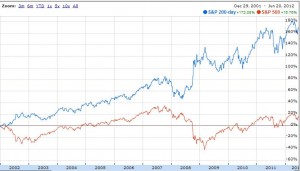When developing trading systems, one of the first things you have to deal with is a high level decision: are you designing a method that trades most or all of the time, or only sporadically? Both approaches are potentially valid, but they require different steps during system design.
Sporadic trading methodologies carry with them a certain philosophy: they assume that any given market is mostly impenetrable to analysis, and only when certain specific rare conditions occur can profitable trades be found. In other words, that a given market is mostly efficient with islands of inefficient pricing. You could think of this as the efficient market hypothesis with caveats. Perhaps the purest example of a sporadic trading approach is mergers & acquisitions arbitrage. The vast majority of the time, when there is no M&A activity for a given symbol, there’s nothing to do. But when a deal is announced, there’s a short window to make your bet on whether the deal will go through and the probability of a better offer materializing.
Continual methodologies assume the opposite: that markets are broadly inefficient, and that as a result there are profitable trading opportunities much or all of the time. The purest manifestation of this would be always-in strategies like the trend following component of the speculative alternatives portfolio. It will be either long or short the S&P 500 100% of the time.
Sporadic trading methodologies usually take the form of a set of restrictive rules or a sequence of events that has to happen before you can enter a trade. The beta neutral spreads component of the speculative alternatives portfolio is an example. You wait for the high yield stock to move 2 standard deviations from its average price, then wait for it to retrace back inside 2 standard deviations, and then bet that it returns to mean (with a beta hedge to help smooth your equity curve out). For that system opportunities tend to arise in any given stock a few times a year, and last a few weeks. The rest of the time, the method has nothing to say about what the price of that stock should be.
Continuous methods typically do some sort of analysis on every single chart bar to determine if the position needs to be switched. In some cases that analysis is simple – in the trend following example it’s frequently comparing the the current price to a moving average. Continuous methods don’t need to be that simple, however – for example Al Brooks’ “Bar By Bar” approach does what amounts to candlestick analysis on every bar and potentially enters or reverses a trade.
It can be very difficult to statistically analyze the performance of continuous trading methods that operate on long time frames. With sporadic methods, you can usually get a large number of discrete trades to look at. But continuous methods may have very few transactions. For example, the S&P trend follow system has only completed 4 trades since 2000, and currently is part way thought the 5th. Intuitively you can look at a chart and see that it’s done well:
(trend following in blue, the base S&P in red)
However with only 4 trades statistical analysis of those trades is not going to be a fruitful approach. You’d need ten times that many just to get started. Generally you do your statistical analysis on some subset of the trade instead – for example you look at every week’s performance for the system and see if those are statistically good. There is some question as to the validity of that analytic approach (it suffers from the same monkey thinking problems as more conventional analysis of whole trades) but it probably is better than nothing.
By now you may be wondering what the big deal is – sure, some trading methods are frequently or always active, and others wait for specific circumstances. Who cares? The reason I raise the issue is that most new traders instinctively bias one way or the other, even when the opposite strategy might be more fruitful. I know I did that – when I started trading I was VERY biased towards sporadic methods because I thought they were easier to analyze. I continued to persist in that belief for years, even though my results weren’t encouraging. Meanwhile I was aware of the basis for the S&P 200 day trend following method but I never looked into it deeply because it was the “wrong kind” of trading strategy. Eventually despaired of finding something to do with my money that was better than lighting it on fire so I tested out the S&P trend following, realized it worked, and shortly thereafter made my first substantial trading profits. Had I simply been less stubborn I would have gotten on the bandwagon a lot sooner.
